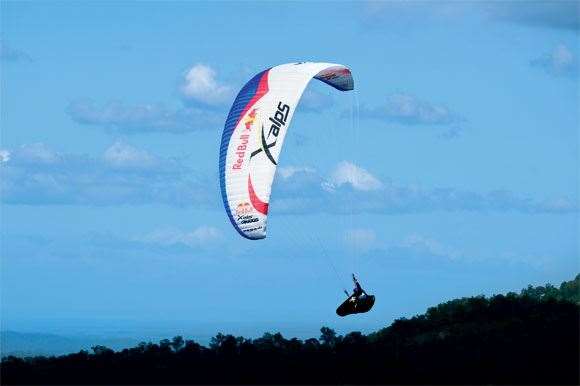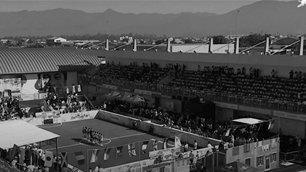Like with most sporting events sponsored by Red Bull, the X-Alps is one hell of a race.
Like with most sporting events sponsored by Red Bull, the X-Alps is one hell of a race.
 photos courtesy of Red Bull
photos courtesy of Red BullAnd we mean hell. The starter’s gun fires in Salzburg, in the granite heart of the Alps, and the finishing line is in Monte Carlo, on the sandy shore of the Mediterranean. That’s 864km of horror terrain - as the crow flies. Factor in the tortuous tracks of the racers and the distance stretches to something approaching 2000km. And the racers’ means of locomotion? Their legs and a single paragliding wing stuffed into their backpacks. Between Salzburg and Monaco there are eight turnpoints they need to hit. How they reach them is up to them, what they eat is up to them, when they sleep is up to them. Last year’s winner, a smiling Swiss called Christian “Chrigel” Maurer, finished in a tick under ten days.By its very nature, the X-Alps tends to attract ice-eyed Austrians and shaggy-haired Swiss. Then there’s 46-year-old Queenslander Lloyd Pennicuik. He’s the kind of bloke who gave up skydiving because it became tedious, the kind of fellow who reckons you should try everything in life at least one. Twice he’s thrown himself into the maelstrom that is the X-Alps. Here’s how he got there.
Learning to fly
“It actually started with a dare. A mate and I did a skydive together back in, gee, ’94 or ‘95. I’d never done anything like that before ‒ I was addicted straight away. And all the way home my mate kept saying to me, ‘Know what we just did? Do you know what we just did? We just tested a frickin’ parachute!’ I thought about this and said, ‘Oh no, you’ve got to be kidding ... ’ Of course, I was back next week! So skydiving was my thing for about two years. But I’d always looked at hang-gliding and thought, ‘Gee, that looks good.’ So eventually I got into that, started flying a power run, then got into proper hang-gliding. I went on to the World Championships with that. By this time I had friends who were paragliding, so I started dabbling in that, just for novelty value. At first I thought it was a bit boring, but gradually I got into it. Then I started thermalling ‒ flying on rising hot air. And once I started doing those long cross-country flights, I was into it. The beauty of paragliding is that your parachute packs into a backpack. So you fly, you land, you walk out to the nearest road, and hitchhike home – easy!”
Good gear
“The better-quality gear flies faster and gives better glide. But as the performance goes up, the safety goes down. It’s hard to explain ... Basically, the higher-performance your wing is, the more prone it is to collapse. Each wing has a bottom surface and a top surface, and these two surfaces are divided by pieces of material that join those two surfaces, leaving gaps at the front of the wing. So the air blows into these gaps, fills the wing, and that gives it its shape. But on high-performance wings the gaps at the front of the wing are much, much smaller, so it doesn’t inflate as easily, and if it does collapse, it doesn’t reinflate as easily. High-performance wings are also typically at a lower angle of attack to the airflow you’re flying through. This makes the wing slicker through the air, but it also means that if you do get some air hitting the top surface of the wing, it can easily collapse. “But the Red Bull X-Alps has really progressed the gear in this sport. They’re now making lighter materials and creating materials with less drag. It’s now at the point where wings and harnesses weigh about eight kilos. It’s incredible that you can fly 400km in something that light.”
The flying mind
“Paragliding isn’t as frightening as most people think. If I’m scared in the air, then it’s been a bad flight; it’s not a nice feeling to be anxious up there. Paragliding should be relaxing, an incredible experience ‒ not the big adrenaline rush people think it is.“Basically, there are two types of pilot. There are people who fly on natural instinct; who fly subconsciously. Then there are other people who are conscious about everything; who make calculated decisions. Generally these two types of pilots are neck and neck in terms of results. “When you’re flying, you have to take in a lot of information. What’s the wind direction? Where are those birds flying? Why are clouds building over there? Is that cloud sucking air into it, or is it blowing air out? There’s so much information out there. I basically compute it all subconsciously – I’m not a calculating pilot. But these days we’re starting to see pilots who are a mixture of both. They can make calculated decisions, but they also fly very naturally.”
Getting high
“How high can you go? It depends where you’re flying. Inland, the cloud base is normally a lot higher, so you can go higher. The closer you are to the coast, the lower the cloud base gets, so you have to stay lower. It’s all to do with humidity, with the amount of water in the air. It gets hard to explain. The average height we fly in Australia is probably around 2000m. During the X-Alps, most of the main mountain tops are around 3000m, so we’re normally sitting at around that height, although we might get above 4000m on a good day, when things are really on.“I don’t normally suffer from altitude, but I have noticed when I’ve been flying at 3000m feet and up that my thinking hasn’t been straight. It’s an effort to think. But I’ve never seen my thinking deteriorate to a degree where it becomes dangerous. Besides, the higher you are, the safer you are. When you’re up in the air, nothing’s going to hurt you; when you’re close to the ground plenty of things are going to hurt you. The most dangerous layer is 100m down. If I’m paragliding in this layer, that’s when I’m really switched on. If I get a collapse in that layer, I don’t have much time to make a decision. Do I try and control the wing? Do I throw my parachute?“I’ve never had to throw my parachute, but there was one time, at a competition in Queensland, when I thought about it. I was in that dangerous layer and I lost control. The wing was completely out of whack and I was getting thrown all over the place. I realised I didn’t have enough time to throw the parachute, so I did something very radical – I stalled the wing. I was about 30m off the ground and I pulled down on the brakes at the back of the wing. Now, this is not something you should ever do! It can straighten your wing out, but it also means your descent rate is a lot faster. My only thinking was that I wanted to hit the ground with my feet, not be pendulum-ed into the ground. Luckily things worked out alright. I landed in a tree – no injuries at all.”
 Photos by Red Bull
Photos by Red Bull
Storm-chasing
“I’ve had a couple of nasty scares in the X-Alps. One time I walked around the bottom of the Marmolada [a 3343m-high mountain in northern Italy], found a good take-off spot, and I’d just come up over a pass when I saw this huge thunderstorm coming. Now, this is not good news. I’m at 2500m above the valley floor and I’m thinking, ‘Oh God, there’s no way I’m making it down to the valley floor, there’s no real protection up here.’ So I thought about it and said, ‘Nope, I’m going to fly off.’ The storm had been sitting stationary in the valley for some time, so I thought I might be able to avoid it. But as soon as I took off it started coming towards me, so I had to make a bee-line the other way, get downwind, and outrun the thing. I remember looking behind me at one stage and I could see lightning bolts hitting the ground, torrential rain ... All the hot air in the valley was lifting, so it was pushing me up. I had to make radical manoeuvres to get back to ground, but the lower I got, the heavier the rain became and I was worried ‒ dropping into this narrow valley ‒ that there might be big gust fronts forming. I won’t say I was terrified ... but for half an hour I was pretty worried. I kept looking up at my wing thinking, ‘How much rain can this thing take?’”
What training?
“The average person would probably take two years of paragliding before they start thermalling; before they start cross-country flying. From that point, there’s not a lot of training. It’s mainly
about talking to people, getting to know all this mental stuff, understanding the information around you. Your skills get to a certain level and after that it’s all about the mental side of things. So my training was just doing as many competitions as I could. I just love the atmosphere; I love the adventure-type people who come to these things.“I once met Novak Thompson in Queensland. Now, Novak’s probably Australia’s best adventure racer. He’s incredible – runs and bikes amazing distances on an hour-and-a-half’s sleep a day. When I met Novak, I asked him how he trains and he told me that his training is his racing. He barely ever trained. Races were enough for him. He told me, ‘Don’t train any more than two or three hours a day, Lloyd. That’s all you need to do. In this sort of racing it’s more about who you are. Some people never give up, others just crumble.’ It’s a good point ‒ this type of racing is more about mental fitness than anything else.”
Going long
“My first X-Alps took me 17 days. During that race we didn’t have very good weather, so most of the time was spent on the ground. And I did pretty well there – I always made up time when I was on the ground running. I wasn’t fast on the ground, but I could go long distances, keep moving for long hours. So I was doing well when the weather was bad. I was averaging about 80km a day on the ground, plus whatever I was doing in the air. During that race I didn’t have any schedule as to when I’d sleep ‒ I just slept when I felt like it. I waited until I was totally exhausted and that was counter-productive because I over-exhausted myself and that affected my flying. During that race I was sleeping around three hours a day, broken up into a couple of blocks. A couple of days I might have slept six hours.“In my second race I was doing very well. On the second day I went from the back of the field to third place ‒ and that was purely because I made good decisions when I was flying. I got a good sleep that night and I had a good route mapped out the next day. Everything was going to plan ... Then I sprained my ankle. Just walking along – simplest thing! I kept going but that night my ankle was completely blown up. I slept a couple of hours that night, then woke and found I couldn’t even put weight on it. So I stumbled on. For the next five days I was limping with this completely swollen leg. On the seventh day I had to quit. I was still doing pretty well, averaging almost 80km a day, but the ankle started affecting my flying. I was so tired and in so much pain that I wasn’t flying well. Them’s the breaks ... ”
Strategy
“In my first X-Alps race everyone thought the favourite ‒ a Swiss bloke called Alex Hofer – was a sure thing. But at the start of the race this Polish bloke we all called ‘The Machine’ just started running. And he just ran the whole race. It was only on a really good day that he’d bother flying. The rest of the time he just ran. Now, everyone had always assumed you can’t win this race on the ground. But this Polish bloke was leading the race until the final day. It was only in the last four hours that Hofer flew this incredible 200km route and overtook him. It just blew everyone away that this bloke could run so fast, for so long. Hofer was calculating, well prepared, took the best routes - everyone had always assumed this was the only way to win the race; everyone had assumed it was all about strategy. But The Machine proved pure fitness is still very important ...
“In last year’s X-Alps, however, Christian Maurer emerged. This bloke is a freak pilot, the Tiger Woods of paragliding, and he came along with this supporter who’d spent six months planning every single possible route. This bloke had the entire Alps sectioned off. Every time Maurer arrived at a point, he had five possible routes to choose from. He had the works. All he had to worry about was flying. And, of course, he won by a mile. So he just showed what planning can achieve.“So it gives you an interesting perspective: over those two years, The Machine showed that you’ve got to be fit; Maurer showed that, yes, you’ve got to be fit, but that you’ve also got
to be strategic.”
‒ Aaron Scott
Related Articles

Aussie baller's Neymar encounter and Brazil skillz sojourn

Iffland jumps into South Africa













